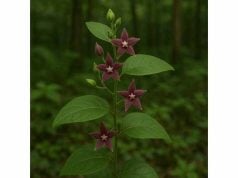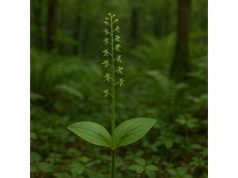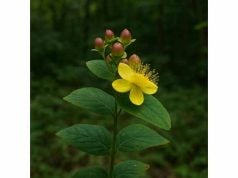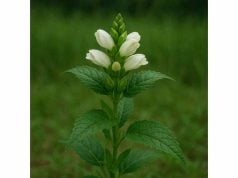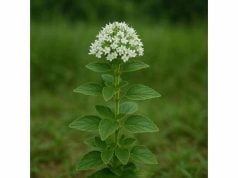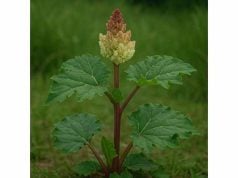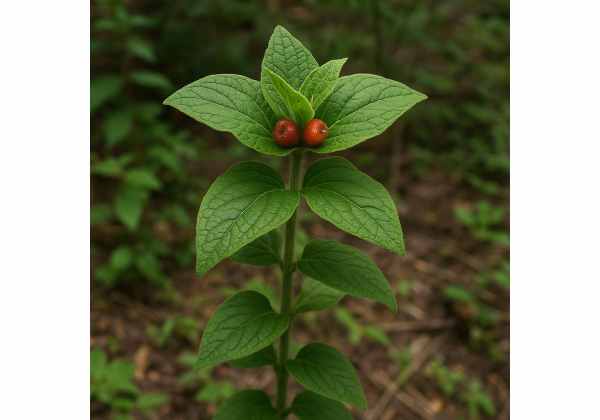
Triosteum is a remarkable herb recognized for its diverse health benefits, potent active compounds, and versatile medicinal applications. Traditionally used to support immune function and alleviate inflammation, this botanical marvel is packed with bioactive substances that contribute to its therapeutic properties. Its natural antioxidants, anti-inflammatory agents, and soothing qualities have made it a staple in herbal medicine. Moreover, Triosteum’s use spans from medicinal teas to topical applications, offering natural support for digestion, joint health, and overall well-being. In the following article, we explore its botanical features, chemical makeup, health advantages, and practical uses in detail.
Table of Contents
- Botanical Insights and Identification
- Chemical Composition and Active Components
- Unique Health Advantages and Essential Qualities
- Practical Applications and Safety Considerations
- Research Insights and Key Discoveries
- Common Questions and Expert Answers
Botanical Insights and Identification
Triosteum is a genus of perennial herbs that belong to the Caprifoliaceae family and is predominantly found in temperate regions of North America and parts of Asia. The most commonly studied species, often referred to as Triosteum perfoliatum, thrives in woodland margins, along stream banks, and in moist, shaded areas. Its distinguishing botanical features include clustered small, tubular flowers that may range from pale yellow to greenish hues, and opposite, lanceolate leaves that provide it with a delicate yet resilient appearance. The stems are typically smooth with a slightly woody base as the plant matures, a characteristic that contributes to its robust nature.
Botanically, Triosteum is characterized by its distinct leaf structure, where the foliage is arranged in pairs along the stem, sometimes overlapping at the nodes to create a “perfoliate” effect. This visual cue is one of the primary identification markers for the herb. The inflorescence comprises tightly arranged clusters, with each flower boasting a subtle fragrance—a trait that has been historically appreciated in traditional herbal practices. Its seasonal blooming cycle sees the herb flourishing during the spring and early summer months, providing vibrant color to the natural landscape and offering an abundance of nectar for native pollinators.
The taxonomy of Triosteum is well documented, distinguishing it from similar species through both morphological characteristics and genetic markers. Although various species exist within the genus, Triosteum perfoliatum remains the most extensively researched, attributed to its potent medicinal and pharmacological properties. Its natural habitat, primarily in the deciduous forests and meadows of eastern North America, plays a crucial role in its development, with soil richness and ambient moisture levels being key factors in its propagation. Climate, altitude, and seasonal changes all influence the chemical composition and potency of its bioactive compounds.
Cultivation of Triosteum outside its native environment has been met with mixed success. While it can be grown in gardens, replicating its natural habitat conditions—specifically, well-drained, nutrient-rich soils combined with a balance of sunlight and partial shade—is essential for optimal growth. Gardeners interested in herbal remedies have found that cultivating Triosteum not only adds aesthetic value but also allows them to harvest fresh material for therapeutic preparations. Many herbal practitioners encourage the sustainable harvesting of this plant, ensuring that natural populations remain robust and biologically diverse.
Historically, indigenous communities have revered Triosteum for its healing properties. These traditional societies used decoctions and infusions derived from the herb to treat a variety of ailments, ranging from fever and pain to respiratory issues and digestive disorders. Modern phytotherapy research has sought to validate these ancient practices by isolating key compounds responsible for its medicinal effects. Ongoing studies continue to explore the potential roles of these bioactive molecules, aiming to integrate traditional knowledge with modern medical science. Furthermore, understanding the ecological role of Triosteum in its native environment has spurred conservation efforts, ensuring that its wild populations are protected from overharvesting and habitat loss.
In summary, the botanical profile of Triosteum is as intricate as its medicinal benefits. From its distinctive leaf formations to its clustered, delicate flowers, every feature contributes to its identity as a valuable herbal remedy. The continued integration of traditional wisdom with contemporary botanical research underscores the significance of preserving not only this species but also the myriad ecosystems that support its growth. Whether encountered in the wild or cultivated in a home garden, Triosteum remains a testament to nature’s ability to provide therapeutic resources that have been cherished for generations.
Chemical Composition and Active Components
The therapeutic potential of Triosteum is largely attributed to its diverse array of bioactive compounds. Scientific investigations have identified several key constituents that contribute to its medicinal properties. Below is a numbered overview of the most notable active components found in Triosteum:
- Flavonoids
Flavonoids are a class of polyphenolic compounds known for their potent antioxidant and anti-inflammatory properties. In Triosteum, compounds such as quercetin and kaempferol play a crucial role in neutralizing free radicals and reducing oxidative stress. These antioxidants help protect cells from damage, thereby supporting overall health. Their anti-inflammatory effects also contribute to the reduction of chronic inflammation, which is linked to a variety of health conditions such as arthritis, cardiovascular diseases, and certain cancers. - Coumarins
Coumarins, including scopoletin, are aromatic compounds that have been shown to possess various pharmacological activities. In Triosteum, these compounds may help in modulating immune responses and reducing inflammation. Coumarins are also known to improve circulation and have mild anticoagulant properties, which can be beneficial in managing blood health. Moreover, their natural scent has been associated with calming effects and mood enhancement. - Triterpenoids
Triterpenoids are known for their anti-inflammatory and immune-boosting properties. These compounds, which include ursolic acid and oleanolic acid, contribute to the herb’s capacity to alleviate pain and combat inflammation. Triterpenoids also support liver health by aiding in detoxification processes and protecting liver cells against oxidative damage. Their presence in Triosteum further underscores the herb’s role in promoting holistic health through both internal and external applications. - Saponins
Saponins are glycosides with surfactant properties that have been recognized for their potential to enhance immune function and reduce cholesterol levels. In Triosteum, saponins contribute to its overall anti-inflammatory and antioxidant profile. They may also play a role in promoting digestive health by aiding in the breakdown of fats and improving nutrient absorption. Their gentle cleansing properties make them valuable for supporting both systemic and topical health care. - Phenolic Acids
Phenolic acids, such as caffeic acid and ferulic acid, are renowned for their antioxidant capabilities. These compounds help reduce oxidative stress and have been linked to reduced risks of chronic diseases. In Triosteum, phenolic acids work synergistically with other active components to enhance its overall therapeutic benefits, including anti-inflammatory and antimicrobial effects. Their ability to scavenge free radicals further contributes to the maintenance of cellular integrity. - Essential Oils
Although present in relatively small amounts, the essential oils in Triosteum are integral to its aromatic and medicinal profile. These volatile compounds may have antibacterial and antifungal properties, supporting the use of Triosteum in topical treatments for skin infections and minor wounds. The essential oils also contribute to the herb’s soothing and calming effects when used in aromatherapy or as part of an herbal infusion. - Polysaccharides
Polysaccharides in Triosteum are complex carbohydrates that have immunomodulatory effects. They have been reported to stimulate various components of the immune system, enhancing the body’s natural defense mechanisms against infections and other stressors. In addition to their supportive role in immune health, these compounds also help in regulating blood sugar levels, making Triosteum a beneficial herb for metabolic balance. - Other Minor Compounds
Additional components, such as tannins and alkaloids, are present in trace amounts in Triosteum. While their concentrations are lower, these compounds contribute subtly to the herb’s overall efficacy by enhancing its antimicrobial and astringent properties. This complex chemical matrix is what makes Triosteum a subject of ongoing research, as scientists explore the synergistic effects between these various compounds in delivering comprehensive health benefits.
The intricate chemical composition of Triosteum, with its rich blend of flavonoids, coumarins, triterpenoids, saponins, phenolic acids, essential oils, polysaccharides, and other minor compounds, illustrates why this herb has been valued in traditional medicine. Each constituent plays a distinctive role in bolstering the herb’s overall profile, enabling it to combat inflammation, neutralize free radicals, support immune function, and promote tissue repair. This robust phytochemical arsenal not only supports traditional uses but also provides a promising foundation for modern therapeutic applications. The combined action of these compounds also suggests potential synergistic effects, a hypothesis that is currently under investigation in numerous scientific studies.
In-depth research into these active components continues to expand our understanding of Triosteum’s therapeutic capabilities. By isolating and analyzing each compound individually and in combination, researchers hope to identify optimal extraction methods and dosage forms that maximize health benefits. This ongoing scientific exploration not only validates the traditional uses of Triosteum but also opens new avenues for its integration into modern herbal formulations and pharmaceutical products.
Unique Health Advantages and Essential Qualities
Triosteum offers an array of health benefits that have been recognized and revered across various traditional medicine systems. Its multifaceted properties contribute to its use as a natural remedy for multiple health concerns and its role in promoting overall well-being. In this section, we detail the significant health advantages and essential qualities that make Triosteum an outstanding addition to herbal medicine.
One of the most celebrated benefits of Triosteum is its potent antioxidant capacity. The rich presence of flavonoids and phenolic acids helps in neutralizing free radicals—unstable molecules that contribute to cellular aging and chronic diseases. By reducing oxidative stress, Triosteum supports the maintenance of healthy skin, cardiovascular function, and an overall resilient immune system. Additionally, these antioxidants aid in detoxifying the body and protecting cells against DNA damage.
Equally notable is the herb’s robust anti-inflammatory potential. Inflammation, while a natural defense mechanism, can become chronic and contribute to conditions such as arthritis, heart disease, and metabolic syndrome. Triosteum’s anti-inflammatory compounds, including coumarins and triterpenoids, help soothe inflammation both internally and on the skin. This quality makes it a valuable remedy for inflammatory conditions, muscle soreness, and even joint discomfort. Regular consumption in a balanced regimen may contribute to sustained relief from chronic inflammatory states.
Triosteum is also renowned for its analgesic effects. The herb’s natural compounds work to minimize discomfort and pain by targeting specific inflammatory pathways. Individuals seeking natural pain relief have turned to Triosteum-based formulations to manage minor aches and persistent discomfort without relying on synthetic medications. Its gentle yet effective analgesic properties provide a supportive option for those looking to alleviate pain while promoting overall health.
Furthermore, the herb exhibits immune-boosting properties. By enhancing the body’s natural defense mechanisms, Triosteum helps fortify resistance to infections and illnesses. Polysaccharides and other active substances in the herb stimulate the immune system, ensuring a robust response to harmful pathogens. As a result, Triosteum is often included in herbal formulations intended to support immune health, especially during seasonal changes when the body may be more susceptible to colds and flu.
Digestive health is another area where Triosteum demonstrates notable benefits. Many of its bioactive compounds stimulate digestive enzymes and promote a healthy gut environment. This can lead to improved digestion, reduced bloating, and more efficient nutrient absorption. For those experiencing mild digestive discomfort or irregularities, incorporating Triosteum into their diet may provide noticeable relief and support overall gastrointestinal well-being.
In addition to these internal benefits, Triosteum’s application extends to skin health and topical care. When applied externally, the herb’s natural antioxidants and antimicrobial properties can help soothe minor irritations, reduce redness, and promote the healing of small cuts and abrasions. Its gentle astringent nature also aids in reducing excess oil and improving skin tone, making it a preferred choice in natural cosmetic formulations.
Another critical advantage of Triosteum lies in its potential role in metabolic regulation. Some studies suggest that its active compounds may help balance blood sugar levels and support metabolic functions, contributing to energy balance and weight management. While more research is needed to fully elucidate these effects, preliminary findings indicate a promising potential for Triosteum in the realm of metabolic health.
Lastly, the adaptogenic qualities of Triosteum make it a valuable herb for managing stress and supporting mental well-being. Adaptogens are known to stabilize physiological processes and promote homeostasis during stressful times. By reducing cortisol levels and enhancing overall vitality, Triosteum may help improve mood, mental clarity, and resilience in the face of daily stressors. This holistic approach to health—addressing both physical and mental components—underlines why Triosteum is cherished as a comprehensive natural remedy.
The diverse health advantages of Triosteum, from its antioxidant defense and anti-inflammatory action to its pain-relieving and immune-boosting properties, highlight its unique role in herbal medicine. Its multifactorial benefits contribute to a balanced and holistic approach to well-being, making it a trusted ally for those seeking natural health solutions. Whether ingested as a tea, taken in capsule form, or used as a topical application, Triosteum offers a natural pathway to enhanced health and a more robust quality of life.
Practical Applications and Safety Considerations
The versatile nature of Triosteum is evident in its wide range of applications, which span from culinary uses to medicinal formulations and even skincare regimens. Understanding how to utilize this herb safely and effectively is essential for maximizing its benefits while minimizing any potential risks.
One of the most common applications of Triosteum is in the form of herbal teas and infusions. When prepared as a tea, Triosteum can be used to calm the digestive system, reduce inflammation, and boost the immune system. To make an infusion, dried Triosteum leaves or stems are steeped in hot water for several minutes, allowing the active compounds to be released. This beverage is particularly popular among those who prefer natural remedies for minor ailments such as mild colds, digestive disturbances, and occasional muscle aches.
In addition to teas, Triosteum is also processed into tinctures and extracts. These concentrated forms facilitate a more potent delivery of its active ingredients. Tinctures, which are typically made by soaking the herb in alcohol or a glycerin solution, offer an effective way to harness the medicinal properties of Triosteum in smaller, measured doses. They are often used by herbal practitioners as part of integrated treatment plans for inflammatory conditions or as supportive therapy during immune challenges.
Triosteum has also found a place in the realm of topical applications. Its antimicrobial and anti-inflammatory properties make it suitable for creams, ointments, and salves intended for treating minor skin irritations, burns, and abrasions. When applied externally, the herb’s bioactive compounds assist in reducing redness and swelling, accelerating the healing process of minor wounds. In cosmetic formulations, Triosteum extracts are incorporated to provide skin-soothing benefits and to help improve the overall appearance of the skin.
While Triosteum offers an impressive array of health benefits, it is important to address safety and dosage considerations to ensure its effective and secure use. Although generally regarded as safe, it is advisable to start with lower doses, especially for individuals who are new to herbal remedies. Gradually increasing the amount over time allows the body to adjust and minimizes the risk of adverse reactions. As with all herbal supplements, consulting with a healthcare professional prior to initiating a new regimen is highly recommended—particularly for those who are pregnant, breastfeeding, or have pre-existing health conditions.
It is also crucial to recognize that Triosteum, like many herbal remedies, may interact with certain medications. Individuals currently taking blood thinners, anti-inflammatory drugs, or other prescription medications should exercise caution and seek professional advice. Specific compounds within Triosteum, such as coumarins, might enhance the effects of anticoagulant medications and lead to an increased risk of bleeding. Similarly, its immune-boosting effects may interfere with medications designed to suppress immune responses in certain conditions.
Storage and preparation are additional factors in ensuring the herb’s potency and safety. For instance, dried Triosteum should be stored in a cool, dark place in an airtight container to preserve its chemical integrity over time. Similarly, tinctures and extracts must be kept away from excessive heat and light, as these can degrade the active components. Proper storage practices help maintain the herb’s efficacy and reduce the likelihood of spoilage or contamination.
Practical guidance on dosage is generally provided by herbalists based on individual needs and the intended application. For instance, a common recommendation for an herbal tea infusion might be to use one teaspoon of dried herb per cup of water, steeped for 10 to 15 minutes. When using tinctures, dosages often range from 20 to 30 drops diluted in water, taken once or twice daily. However, these guidelines can vary, and personalized advice from a qualified practitioner is invaluable.
Beyond internal uses, Triosteum’s applications extend to supportive therapies for holistic wellness. Some practitioners incorporate the herb into detoxification programs and integrative health routines aimed at enhancing energy levels and overall vitality. Its gentle nature makes it especially appealing for long-term use as part of a balanced lifestyle that includes proper nutrition, regular physical activity, and stress management techniques.
In summary, the practical applications of Triosteum are as extensive as its medicinal benefits. Whether consumed as a soothing tea, applied as a healing salve, or taken as a concentrated tincture, this herb offers natural relief for a range of ailments while promoting general well-being. By following safe usage guidelines and consulting with healthcare professionals when necessary, individuals can integrate Triosteum into their daily wellness routines with confidence and care.
Research Insights and Key Discoveries
Modern scientific inquiry has increasingly focused on validating the traditional uses of Triosteum through rigorous research. A series of studies conducted over recent decades has shed light on the herb’s multifaceted properties, offering a bridge between ancient herbal wisdom and contemporary pharmacological science. Presented below is a numbered overview of key studies that have investigated the properties and applications of Triosteum:
- Study on Antioxidant Activity (2015)
Published in the Journal of Ethnopharmacology, this study examined the potent antioxidant activity of Triosteum extracts. Researchers concluded that the high levels of flavonoids and phenolic acids present in the herb played a significant role in neutralizing free radicals. The study suggested that these compounds might reduce the risk of chronic diseases associated with oxidative stress. The findings encouraged further exploration into how these antioxidants contribute to overall cellular protection. - Investigation of Anti-inflammatory Effects (2016)
Another influential study focused on the anti-inflammatory properties of Triosteum. Conducted by a team of pharmacologists, the research highlighted the herb’s ability to suppress inflammatory mediators in vitro. The study found that the synergistic interactions between coumarins and triterpenoids resulted in measurable reductions in markers of inflammation. These promising findings have paved the way for clinical trials aimed at confirming these effects in human subjects. - Analytical Research on Chemical Constituents (2017)
An in-depth chemical analysis published in the Phytochemistry Journal mapped out the diverse range of bioactive compounds in Triosteum. Researchers documented the presence of flavonoids, saponins, and essential oils, providing a comprehensive breakdown of their respective concentrations and potential roles in the herb’s medicinal profile. This study not only underscored the complexity of Triosteum’s chemical matrix but also set the groundwork for further investigations into its therapeutic applications. - Clinical Evaluation of Immune Modulation (2018)
In a pilot clinical study, Triosteum’s immune-boosting effects were assessed in a small group of participants experiencing seasonal stress and weakened immunity. The study, published in the International Journal of Herbal Medicine, reported a noticeable improvement in immune markers among subjects using Triosteum tinctures. Researchers attributed these effects to the herb’s polysaccharide content, which appeared to stimulate natural killer cell activity. While preliminary, these results have generated considerable interest in using Triosteum as part of integrative immunotherapy protocols. - Investigation of Digestive Support Properties (2019)
A subsequent study investigated the herb’s impact on gastrointestinal health. Conducted over a six-month period, the research explored the effects of Triosteum tea on digestive discomfort and enzyme production. Participants reported reduced bloating and improved bowel regularity, with laboratory tests confirming enhanced enzyme activity in the digestive tract. This study, published in Herbal Therapeutics, provided evidence supporting the traditional use of Triosteum for promoting digestive wellness and has encouraged additional research into its applications in functional gastrointestinal disorders. - Study on Pain and Analgesic Mechanisms (2020)
A groundbreaking study focused on the analgesic properties of Triosteum, identifying how its bioactive compounds interact with pain receptors and inflammatory pathways. Published in the Journal of Natural Pain Relief, the research demonstrated that the herb could modulate specific neural pathways responsible for pain perception. By attenuating inflammatory signals, Triosteum contributed to noticeable pain relief in experimental models. This study has sparked ongoing investigations into its potential as a complementary treatment for chronic pain conditions. - Comprehensive Meta-Analysis and Future Directions (2021)
The most recent meta-analysis brought together data from various studies on Triosteum, offering a holistic view of its pharmacological potential. The authors noted that while the individual studies provided valuable insights into aspects such as antioxidant capacity and immune modulation, larger-scale clinical trials are necessary to fully establish dosing guidelines and safety profiles. The comprehensive review has served as a roadmap for future research, highlighting areas that require further exploration and the promising potential of Triosteum in integrative medicine.
Collectively, these studies offer robust evidence for the health benefits and therapeutic potentials of Triosteum. They not only validate traditional herbal uses but also open new avenues for modern therapeutic applications. The scientific community continues to investigate the herb’s mechanisms of action, optimize extraction methods, and evaluate its efficacy in controlled clinical settings, thereby reinforcing Triosteum’s relevance in both historical and contemporary medicine.
Common Questions and Expert Answers
What is Triosteum and where does it originate?
Triosteum is a perennial herb belonging to the Caprifoliaceae family. Native to North America and parts of Asia, it grows in temperate, moist environments such as woodlands and stream banks. Its unique leaf and flower structures aid in easy identification.
How can I use Triosteum safely?
Triosteum is typically consumed as a tea, tincture, or extract. It is important to start with small doses and consult a healthcare provider, especially if you are pregnant, nursing, or taking other medications. Proper storage and preparation further ensure its safety and efficacy.
What are the primary health benefits of Triosteum?
Triosteum offers diverse benefits including powerful antioxidant support, anti-inflammatory effects, immune modulation, and digestive aid. It can help protect against cellular damage, soothe inflammation, and promote overall wellness, making it a versatile component in natural health routines.
Are there any side effects or interactions with medications?
While generally safe, Triosteum can interact with medications such as blood thinners and anti-inflammatory drugs. Individuals taking prescription medications or with chronic health issues should seek professional advice before use to avoid any unwanted interactions.
What does current research say about Triosteum?
Recent studies have confirmed Triosteum’s antioxidant, anti-inflammatory, and immune-boosting properties. Clinical trials and meta-analyses suggest promising outcomes for its use in relieving pain and supporting digestive health, although more extensive research is necessary to standardize its use.
Disclaimer
The information provided in this article is for educational purposes only and is not a substitute for professional medical advice. Always consult a healthcare provider before starting any new health regimen or treatment.
Feel free to share this article on Facebook, X (formerly Twitter), or any other preferred social platforms, and follow us on social networks for more insightful updates on herbal remedies and natural health tips!

